Know the Etymology: 56
Place Name of the Day: Sunday, 18 June 2017
Ālaṭi, Aracaṭi, Vēmpaṭi, Taṇakkaṭi, Tillaiyaṭi, Taṭaṅkan-puḷiyaṭi, Pīnāṟi-marattaṭi, Cūḷaiyaṭi, Irāttalaṭi/ Rāttalaṭi
ஆலடி, அரசடி, வேம்படி, தணக்கடி, தில்லையடி, தடங்கன் புளியடி, பீநாறி மரத்தடி, சூளையடி, இறாத்தலடி/றாத்தலடி
Ālaṭi, Aracaṭi, Vēmpaṭi, Taṇakkaṭi, Tillaiyaṭi, Taṭaṅkan-puḷiyaṭi, Pīnāṟi-marattaṭi, Cūḷaiyaṭi, Irāttalaṭi/ RāttalaṭiĀl+aṭi
Aracu+aṭi
Vēmpu+aṭi
Taṇakku+aṭi
Tillai+aṭi
Taṭaṅku+am+puḷi+aṭi
Pī+nāṟi+maram+attu+aṭi
Cūḷai+aṭi
Irāttal+aṭi
The locality of the Āl tree
The locality of the Aracu tree
The locality of the Taṇakku tree
The locality of Tillai trees
The locality of the tamarind tree where the cattle impound is located
The locality of the Pīnāṟi tree
The locality of the kiln
The spot or locality where fish catch is weighed for taxation
| Aṭi | locality, place, neighbourhood, surroundings (Tamil, toponymic usage); foot, sole, hoof, footprint, base, bottom, underneath, source, origin (Tamil, DED 72, Kuṟuntokai, 138: 3; 243: 1; 262: 5-8; Akanāṉūṟu, 55: 3); place (Tamil, MTL, Piṅkalam 719); nearness, proximity (Tamil, MTL); sole, footstep, bottom, base (Malayalam, DED 72); cognates in 11 Dravidian languages; Āḻ: (verb) to sink, plunge, dive, be deep, fall down (Tamil, DED 396, Ḻ/ Ṭ/ Ḍ change); Aḍi: foot, measure of foot, step, pace, base, bottom, under (Kannada, DED 72); place below, down (Kodagu, DED 72); bottom, base (Tulu, DED 72); beneath, below, low (Gondi, DED 72); foot, footstep, the bottom of anything (Sinhala, Clough, Sorata); Aḍugu: foot, footstep, step, pace, measure of a foot, bottom, basis (Telugu, DED 72); Yaṭi, Yaṭa: (adjective) under, below, beneath (Sinhala, Clough); Yaṭi: lower (Brahmi inscription, IC, Vol I, 143). See column 178 for toponymic usages in Sinhala. |
| Āl | also Ālam: banyan tree, Ficus bengalensis, Ficus indica (Tamil, DED 382, Naṟṟiṉai, 76: 3; Akanāṉūṟu, 70: 15-16; cognates in 10 Dravidian languages); probably from the aerial roots of the tree; Ńāl, Nāl: (verb) to hang, swing, dangle, be suspended (Tamil, DED 2912, Akanāṉūṟu, 156: 14; Kalittokai, 96: 11); Āl: rope (Tamil, Cūṭāmaṇi. 11: 223) |
| Aracu | Pipal tree/ Bō-tree, Ficus religiosa (Tamil, DED 202, Peruṅkatai, 36: 224, cognates in 7 Dravidian languages); 1. Aracu, Araicu: kingliness, king (Tamil, DED 201, Naṟṟiṇai, 346: 3; cognates in 8 Dravidian languages); 2. Probably from the rustling sound of the leaves, Aracal, onomatopoeic; Ār: (verb) to roar (Tamil, DED 367); Ārcu, Ārucu: (verb) to roar (Telugu, DED 367); Aṟai: (verb) to sound (Tamil, 319); Aṟacu, Aṟucu, Arcu: (verb) to clamour (Kannada, DED 319) |
| Vēmpu | neem, margosa, Azadirachta indica (Tamil, cognates in 8 Dravidian languages, DED 5531, Kuṟuntokai, 24: 1); also Vēppu: (Tamil, Akanāṉūṟu, 176: 8) |
| Taṇakku | 1. A tree, whirling nut, Gyrocarpus jacquini (Tamil, Malayalam, DED 3046); Taṇuku: Gyrocarpus jacquini (Telugu, DED 3046); 2. A flowering tree in which flowers blossom as a cluster, "Pal-pūn-taṇakkam," Morinda umbellata (Tamil, MTL, Kuṟińcippāṭṭu, 85); 3. Another tree, Elephant Rope Tree, Sterculia villosa (Tamil, MTL). The first one is the most appropriate to the context |
| Tillai | a salt-marsh tree, Blinding Tree, as the milky sap of it could cause blindness, Excoecaria agallocha; also another specie, Excoecaria crenulata (Tamil, DED 3256, Kuṟuntokai, 195: 2-3; the name Tillai-ampalam for Citamparam temple has come from Tillai forest that had existed at that place); Tella: Excoecaria agallocha (Telugu, DED 3256); Tela-kīriya: Excoecaria agallocha (Sinhala, Clough) |
| Taṭaṅkaṉ | meaning cattle impound in this context; from Taṭaṅku: (verb) to be obstructed (Tamil, DED 3031); Taṭaṅkal: obstruction (Tamil, Cūḷāmaṇi, 212); Taṭu: (verb) to hinder, stop, obstruct, forbid, check, restrain, control (Tamil, DED 3031, cognates in 11 Dravidian languages) |
| Puḷi | (noun) tamarind, acidity, tartness; (verb) to turn sour, (Tamil, DED 4322, Kuṟuntokai, 287: 4). See column 179 |
| Pīnāṟi | also Pī-nāṟi-maram: a tree bearing flowers of faecal stench, Fetid Tree, Sterculia foetida (Tamil, MTL); from Pī: excrement, faeces (Tamil, DED 4210, cognates in 19 Dravidian languages); Nāṟi: one that smells; from Nāṟu: (verb) to emit good or bad smell (Tamil, DED 2918, cognates in 8 Dravidian languages); |
| Maram | tree, wood, timber (Tamil, DED 4711a, cognates in 20 Dravidian languages) |
| Cūḷai | kiln, furnace (Tamil, DED 2709, Puṟanāṉūṟu, 228: 2-3); Cuḷḷai: potter's kiln (Tamil, DED 2709, Tivākaram, 5: 191); Cullī: fireplace (Sanskrit, etymology traced to Dravidian, CDIAL 4879); Cuṭu: (verb) to be hot, to burn, roast, toast, bake, burn as bricks in a kiln (Tamil, DED 2654, cognates in 18 Dravidian languages); Cūṭu: heat, that which is heated, burnt (Tamil, DED 2654) |
| Iṟāttal | also Rāttal: a place where custom is paid for fish (Tamil, MTL citing Jaffna diction); from Iṟāttal, Irāttal: 1. One pound of weight, a unit of measuring weight equal to 454 grams (MTL, citing Jaffna diction); 2. Arabian pound; 3. A Jewish measure of weight (Tamil, MTL); from Ratl: a unit of measuring weight (Urdu, MTL) |
Aṭi is a commonly found component that usually comes at the end of Tamil place names. It doesn't come alone. When it comes as a suffix, it means locality, place, neighbourhood or surroundings of the one that comes in the prefix.
The toponymic meanings derive from Aṭi basically meaning foot, sole, base, bottom, underneath etc. The term is listed as Dravidian (DED 72).
Sinhala has a cognate Aḍi/ Aḍiya with meanings identical to the basic meanings of Aṭi in Tamil. But its toponymic usage is uncommon in Sinhala place names. It is mostly found in some Sinhalicised Tamil place names. See column 178 for Aḍiya-related and Yaṭi-related place names.
* * *Ālaṭi is noticed as a place name or locality name in several places throughout the traditional Tamil region of the island. One example is Ālaṭi in Kārainakar Island of Jaffna district.
Aracaṭi also comes in several places throughout the Tamil region. One example is Aracaṭi in Trincomalee Town and Gravets division of Trincomalee district.
Vēmpaṭi is another popular toponym like Ālaṭi and Aracaṭi. One example is Vēmpaṭi in Jaffna City, Jaffna district.
Taṇakkaṭi is noticed as a locality name in Kurumpaciṭṭi East, in Valikamam North division of Jaffna district and in Mātakal in Valikamam Southwest division of Jaffna district (the latter noted by Arul Subramaniyam).
Tillaiyaṭi is a place located by the side of a lagoon and sea arm near Kaṟpiṭṭi town in Kalpitti division of Puttalam district (Kalpitiya OIS).
Taṭaṅkaṉ-puḷiyaṭi is a locality in Nelliyaṭi in Vadamaradchi Southwest division of Jaffna district.
Pīnāṟi-marattaṭi is a locality in Kokkuvil in Nallur division of Jaffna district.
Cūḷaiyaṭi is a locality in Nallur division of Jaffna district (Balasundaram, p. 382)
Iṟāttalaṭi/ Rāttalaṭi is seen as a locality name in Vaṭṭukkōṭṭai in Valikamam West division of Jaffna district and in Polikaṇṭi in Vadamaradchi Northeast division of Jaffna district (Balasundaram, p. 173)
* * *Some related place names:Aṭi:Toṭṭilaṭi: Caṅkāṉai, Valikamam West, Jaffna. Toṭṭil: a tree bearing fruits hanging like cradles (Toṭṭil), Spathodia indica, Bignonia indica. See column 153
Kuṇṭaṭi: Cutumalai (Balasundaram, p. 165). Kuṇṭu: natural pond, waterhole. See column 279
Villaṭi: Poonakari Kilinochchi. Vil: see column 10
Pantiyaṭi: Cutumalai, Valikamam Southwest, Jaffna (Balasundaram, p. 165). Panti: shed, stable, see column 247
Īńcaṭi: Cutumalai North, Valikamam Southwest, Jaffna (V. Almanac, 2013-14, p. 92), Īńcu: a small species of date palm (Tamil, DED 2617). See column 198
Vaṅkaḷāvaṭi: Vēlaṇai East, Kayts, Jaffna. Vaṅkaḷā: Bangalow
Kiṇṇaiyaṭi: Vaḻaiccēṉai, Koralaippattu Central, Batticaloa (V. Almanac p. 96). Kiṇṇai: an estuarine or coastal mangrove tree, bearing a small, globular, casket shaped fruit, Sonneratia caseolaris (Tamil)
Piṉṉaiyaṭi: Vāḻaiccēṉai, Batticaloa. V. Almanac, p. 102. Piṉṉai: = Puṉṉai (DED 4343), see column 54
Paṉiccaiyaṭi: Maṇmuṉai, Batticaloa (HAM temple records). Paṉiccai: a tree, Diospyros embryopteris (Tamil, DED 4036)
Nelliyaṭi: Vadamaradchi Southwest, Jaffna. Nelli: Indian gooseberry, Phyllanthus emblica, see column 374
Tāḻaiyaṭi: Vadamaradchi East, Jaffna. Tāḻai: fragrant screw pine (Tamil, DED 3183). See column 204
Mullaiyaṭi: Pachchilaippaḷḷi, Kilinochchi. Mullai: see column 42
Kattāppu-marattaṭi: Kuccaveḷi, Trincomalee. Kattāppu-maram: Indian Almond (Tamil, MTL); from Catapang: Indian Almond (Malay, cited by MTL)
Uṭalaiyaṭi: Mantai West, Mannar. Uṭalai: probably, Uṭai: acacia or Uṭacam: Wrightia tinctoria
Uvāyaṭi: Mannar Town, Mannar. Uvāy: a tree, see column 218
Kaḷḷiyaṭi: Mantai West, Mantai. Kaḷḷi: milk hedge, see column 70
Muruṅkaiyaṭik-kuḷam: Madu, Mannar. Muruṅkai: 1. Indian horse-radish tree, Moringa pterygosperma (Tamil, DED 4982); 2. Muruṅkai, Murukku: Butea frondosa (Tamil, DED 4981, Akanāṉūṟu, 1: 16; 362: 5)
Paṉaiyaṭik-kuḷam: Madu Mannar. Paṉai: Palmyra palm, see column 244
Tuvaraiyaṭi-vāṉ: Nanaddan, Mannar. Tuvarai: a shrub or small tree, see column 96
Mutiraiyaṭi: Addalaichchenai, Amparai. Mutirai: a tree, see column 54
Kūḻāvaṭi: Koralaippattu, Batticaloa; Manmunai North, Batticaloa. Kūḻā: a tree, Cordia myxa, see column 41
Cekkaṭik-kuḷam: Madu, Mannar. Cekku: oilmill, see column 4
Āḻak-kiṇattaṭi: Polikaṇṭi, Vadamaradchi Northeast, Jaffna (Balasundaram, p. 173). Āḻa: deep; from Āḻam: depth; Āḻ: (verb) to sink, be deep (Tamil, DED 396); Kiṇaṟu: well (Tamil, DED 1998)
Ēḻu-puḷiyaṭi: Polikaṇṭi, Vadamaradchi Northeast, Jaffna (Balasundaram, p. 173)
Pammiyaṭi: Eravurpattu, Batticaloa. Pammi: probably Vammi: a tree
Tuṟaiyaṭi-vaṭṭai: Eravurpattu, Batticaloa. Tuṟai: see column 45
Taikāvaṭi-veṭṭai: Eravur Town, Batticaloa. Taikkā: 1. The place where a Muhammadan saint is interred; 2. A Fakir's hut (Tamil, MTL); from Takya (Persian, cited by MTL)
Kaṉṟup-puḷiyaṭi: also Kaṇṭup-puḷiyaṭi: Polikaṇṭi, Vadamaradchi Northeast, Jaffna (Balasundaram, p. 173). Kaṉṟu, Kaṇṭu: sapling, young tree (Tamil, DED 1411)
Cantam-puḷiyaṭi: Karainagar, Jaffna
Āṭṭup-paṭṭiyaṭi: Polikaṇṭi, Vadamaradchi Northeast, Jaffna (Balasundaram, p. 173). Āṭu:
Vāṭiyaṭi: Poonakari, Kilinochchi. Vāṭi: fish curing yard, hamlet, rest house, hut, enclosure, garden, yard, shed (Tamil, MTL); wall, courtyard, house (Tamil, MTL citing Jaffna Dictionary). In the context of the place, it is a tiny Dutch fortress or fortified check-post; Pāṭi: military camp (Tamil, Caṅkam diction, Mullaippāṭṭu 28). See column
Miṉāraiyaṭi: Mannar Town, Mannar. Minār: prayer-call tower attached to a mosque (Minare: Turkish; Manāra: lighthouse, Arabic; Minār: fire, light, Arabic; Concise Oxford)
Kaṉakam-puḷiyaṭi: Caracālai, Thenmaradchi, Jaffna
Attiyaṭi: Tuṉṉālai, Vadamaradchi Northeast; Pulōli (Balasundaram, p. 211, 393)
Tāmaraik-kuḷattaṭi: Tuṉṉālai, Vadamaradchi Northeast (Balasundaram, p. 211): Tāmarai: lotus, see column 5
Intirammaṉ-kōyilaṭi: Tuṉṉālai, Vadamaradchi Northeast (Balasundaram, p. 211). Kōyil, Kōvil: temple (Tamil, DED 2177)
Marutaṭi: Māṉippāy, Valikamam Southwest, Jaffna. Marutu: Terminalia arjuna, see column 386
Māvaṭi: Vaṭṭukkōṭṭai, Valikamam, Jaffna. Mā: mango tree (Tamil, DED 4782)
Ōṭṭa-māvaṭi: Koralaippattu West, Batticaloa. Ōṭṭa: 1. According to one local explanation, from Ōṭṭai: hole (Tamil, DED 946), a mango tree that had a large hole; 2. From Ōṭṭaṉ: runner, person doing runner service, messenger (Tamil, DED 1041, Eezham Tamil inscription, 1150 CE, Vihārahinna, Subbarayalu, 2012, p. 204); from a stage in the runner service of the past
Pālaiyaṭi: Puttūr, Valikamam East, Jaffna; Pulōli, Point Pedro, Jaffna (Balasundaram, p. 215, 393). Pālai: a tree, see column 47
Nīrāviyaṭi: Vaṇṇārpaṇṇai, Nallur, Jaffna. Nīrāvi: see column 15
Ilakaṭi: Kōppay; Alvāy (Balasundaram, p. 252, 386). Ilaku: = Ilavu: silk cotton tree, Bombax malabaricum (DED 495)
Kālaiyaṭi: Paṉippulam, Valikamam West, Jaffna (Balasundaram, p. 260). Kālai: enclosure, cattle pen, shed, depot; see column 488
Maṭattaṭi: Kantarōṭai, Valikamam South, Jaffna (Balasundaram, p. 72). Maṭam: see column 190
Koṭṭaṭi: Jaffna City, Jaffna; Accuvēli; Iṭaikkāṭu (Balasundaram, p. 319, V. Almanac, p. 97). Koṭṭu: see column 379
Āyattaṭi: Kaitaṭi; Eḻutumaṭṭuvāḷ (Balasundaram, p. 341, 366). Āyam: see column 472
Kaitaṭi: Thenmaradchi, Jaffna
Vēlaṭi: Mayiliṭṭi, Valikamam North, Jaffna (Balasundaram, p. 354). Vēl: babul tre, acacia (Tamil, DED 5537)
Perukkaṭi: Puṅkuṭutīvu, Kayts, Jaffna (Balasundaram, p. 154). Perukku: baobab tree, see column 475
Kōriyaṭi: Vettilaikkēṇi, Vadamaradchi East, Jaffna. Kōri: a tower built to mark the shore for vessels, obelisk, beacon (Eezham Tamil usage)
Kuntāvaṭi: Neṭuntīvu, Jaffna (Delft OIS); Kuntā: a tower built to mark the shore for vessels, obelisk, beacon (Eezham Tamil usage)
Kōriyāvaṭi: Puṅkuṭutīvu, Kayts, Jaffna (Balasundaram, p. 154). See Kōriyaṭi
Caṅku-mālaṭi: Puṅkuṭutīvu, Kayts, Jaffna (Balasundaram, p. 154). Māl: shed
Cantaiyaṭi: Puṅkuṭutīvu, Kayts, Jaffna (Balasundaram, p. 154). Cantai: market
Kallaṭi: Manmunai North, Batticaloa; Verukal, Trincomalee
Puṅkaṭi: Kaccāy, Thenmaradchi, Jaffna (V. Almanac, 2013-14, p. 103)
Mańcattaṭi: Iṇuvil, Valikamam South, Jaffna. From a shed built to keep an ornamenal temple vehicle; Mańcam: canopied vehicle for idols of a temple (Tamil, MTL citing Jaffna diction); bedstead, couch, cot (Tamil, Pinkalam, 1663; Cūḷāmaṇi, 1779); Maccu: upper story (Tamil, Malayalam, DED 4631); Mańca: stage, platform, bed (Sanskrit, CDIAL 9715)
Kuruntaṭi: Tellippaḻai, Valikamam North, Jaffna (V. Almanac, 2013-14, p. 97). Kuruntu: wild lime tree (Tamil, DED 1789)
Koṇṭalaṭi: Nallūr, Jaffna. Koṇṭal: variation of Koṉṟai, Cassia fistula (Tamil, DED 2175)
Nāvalaṭi: near Kaṟpiṭṭi town, Kalpitti, Puttalam (Kalpitiya OIS); Batticaloa (V. Almanac, 2013-14. P. 96)
Toṭṭiyaṭi: Vicuvamaṭu, Puthukkudiyiruppu, Mullaiththeevu (V. Almanac, 2013-14, p. 91). Toṭṭi: water-trough, tub, cistern, manger, crib (Tamil, DED 3484)
Āttiyaṭi: Pulōli West, Point Pedro, Jaffna (V. Almanac, p. 90). Ātti, Ārai: a flowering tree or shrub, Bauhinia racemosa (Tamil, DED 372);
Attiyaṭi: Jaffna City, Jaffna; Tuṉṉālai, Vadamaradchi Northeast, Jaffna. Atti: country fig, Ficus glomerata (Tamil, DED 144)
Kēṇiyaṭi: Vīmaṉkāmam, Valikamam North, Jaffna (V. Almanac, 2013-14, p. 98)
Vilvaiyaṭi: Puṅkaṅkuḷam, Jaffna (V. Almanac, 2013-14, p. 102). Vilvai: Vilvam: Aegle marmelos
Kayaṭṭaiyaṭi: Muḷḷiyavaḷai, Mullaiththeevu (V. Almanac, 2013-14, p. 103). Kayaṭṭai: a tree (Eezham Tamil); probably the same as Kahaṭa: Patana Oak, Careya arborea (Sinhala, Clough); also bitter, acrid, astringent (Sinhala, Clough); Kacaṭṭai: astringency as of an unripe fruit (Tamil, DED 1249); Kayar, Kacar: astringency (Tamil, DED 1249); Kaya, Kai: (verb) to be bitter, astringent (Tamil, DED 1249); the medicinally used bark of the tree and gum of the fruit are astringent
Tāṇṭiyaṭi: Thirukkovil, Amparai. Tāṇṭi: Tāṉṟi: a tree, Terminalia bellerica, see column 117
Pirappaiyaṭi-maṭu: Koralaippattu North, Batticaloa. Pirampu: rattan cane (Tamil, DED 4175)
Āyilaṭic-cēṉai: Koralaippattu, Batticaloa. Āyil: a tree, see column 78
Iluppayaṭi-muṉmāri: Koralaippattu, Batticaloa. Iluppai: Bassia longifolia (Tamil, DED 485), see column 175)
Kāraiyaṭip-paṭṭi: Koralaippattu, Batticaloa. Kārai: a thorny shrub, see column 68
Elumiccaiyaṭi: Koralaippattu, Batticaloa. Elumiccai: sour lime (Tamil, DED 836)
Karuṅkāliyaṭic-cēṉai: Koralaippattu, Batticaloa. Karuṅkāli: ebony (Tamil, DED 1282), see column 96
Tēṟṟā-marattaṭi: Navāli North, Jaffna (V. Almanac, 2013-14, p. 105). Tēṟṟā, Tēttā: clearing-nut tree, see column 42
Tēttāvaṭi: Mannar Town, Mannar. See Tēṟṟā-marattaṭi
Maṇṭapattaṭi: Manmunai West, Batticaloa. Maṇṭapam: hall, hall in a temple or palace, temporary saloon or open shed, public hall or rest house (Tamil, MTL, Paripāṭal, 19: 53; Cilappatikāram, 28: 79); Maṇḍapa: open temporary shed, pavilion (Sanskrit, non-IA origin cited, CDIAL, 9740). See column 190
Puṭṭiyaṭit-tuṟai: Poratheevuppattu, Batticaloa. Puṭṭi: mound
Makiḻaṭit-tīvu: Manmunai South, Batticaloa. Makiḻ: a tree, Mimusops elengi, see column 475
Caravaṇaiyaṭi-ūṟṟu: Poratheevuppattu, Batticaloa. Caravaṇai: a kind of aquatic reed
Vammiyaṭi-ūṟṟu: Poratheevuppattu, Batticaloa. Vammi: a tree
Pālattaṭic-cēṉai: Moothoor, Trincomalee. Pālam: bridge (Tamil, DED 4099)
Cōlaiyaṭi: Trincomalee Town and Gravets, Trincomalee. Cōlai: grove (Tamil, DED 2891). See column 54
Camuḷayaṭi-vaṭṭai: Poratheevuppattu, Batticaloa. Camuḷai: a tree, see column 54
Malaiyaṭi: Damana, Amparai; Nayinā-tīvu, Kayts, Jaffna. Malai: see column 19
Kīriyaṭit-tāḻvu: Nanaddan, Mannar. Kīri: see column 19
Viḻiṉaiyaṭi: Sammanthurai, Amparai. Viḷiṉai: a tree (Batticaloa usage, Kanthaiya. V. C., p. 463)
Ciṟuttalaiyaṭi: Karaithuraippattu, Mullaiththeevu
Pātiriyaṭi: Ampaṉai, Tellippaḻai, Valikamam North, Jaffna. Pātiri: trumpet flower tree, Stereospermum chelonoides (Tamil, DED 4075)
Ālaiyaṭi-vempu: Alaiyadivempu, Amparai. Ālai: see column 4
Teṉṉaimaravaṭi: also called Teṉṉaimara-vāṭi: Kuchchaveli, Trincomalee. See Teṉṉai-marattaṭi
Teṉṉai-marattaṭi: Karaithuraippattu, Mullaiththeevu. Teṉṉai: coconut tree (Tamil, DED 3408); Teṉ: coconut tree (Tamil, DED 3408, Cūṭāmaṇi, 9: 12); Teṅkam: coconut tree (Tamil, DED 3408, Appar, 6: 73: 2); Teṅku: coconut tree (Tamil, DED 3408, Puṟanāṉūṟu, 61: 9; Porunarāṟṟuppaṭai, 208; Perumpāṇāṟṟuppaṭai, 364; Paṭṭiṉappālai, 16; Patiṟṟuppattu, 13: 7); Tēṅ-kāy: coconut (Tamil, DED 3408); cognates in 8 Dravidian languages; 1. Tēm: sweetnes (Tamil, DED 3268a); Tēn: honey (Tamil, DED 3268b); 2. Teṉ: south, southern region (Tamil, DED 3449)
Cuṭukāṭṭu-ālaṭi: Jaffna City, Jaffna district. Cuṭu-kāṭu: cremation ground (Tamil, DED 2654+1438)
* * *Pīnāṟi:Pīnāṟit-toṭuvāyt-tōṭṭam: Pēcālai, Mannar (Talaimannar OIS)
* * *Tillai:Tillaṅ-kuḻi: Caracālai, Thenmaradchi, Jaffna (Point Pedro OIS). Tillai+am+kuḷi > Tillam+kuḻi > Tillaṅkuḻi
Tillaiyiṭṭi: Aḻaveṭṭi, Valikamam North, Jaffna (Balasundaram, p. 189). Tillai+iṭṭi
Tillai-mōṭṭai: Talaivillu, Kaṟpiṭṭi, Puttalam (Kalpitti OIS)
* * *Notes:Pīnāṟi:Pīnāṟi (Sterculia foetida) is a timber tree of the tropical rain forests. It is a native of tropical Africa, southern South Asia, Southeast Asia and northern Australia.
The names of this tree in various languages have either come from the faecal stench of its flowers or from its edible, oil-producing seeds.
The Latin botanical term, Sterculia foetida itself means, 'stinking dung' (stercus: manure; foetida: stinking). The tree is known in English as Javan Olive, Skunk Flower, Hazel Sterculia, Wild Chestnuts, Wild Indian Almond and Bastard Poon Tree.
The Sinhala name Telaṁbu (Tel+aṁbu) has probably come from its oil-producing seeds (tel: oil).
The tree, related to Cacao and Silk Cotton trees, blossoms in the early part of the year, before the appearance of the sprouts of leaves. This is the time when it stinks.
The fruits mature 11 months later and burst open into four sections, exposing the seeds inside.
The seeds are recognized as a famine food, eaten raw as well as roasted in Deccan and South India. The oil extracted from it is of medicinal value. In East Indonesia, the oil was used in lighting lamps.
This majestic and useful tree of beautiful flowers is despised for the stench and is rarely found in inhabited places. But in some parts of the world it is found planted for shade on the sides of roads.
* * *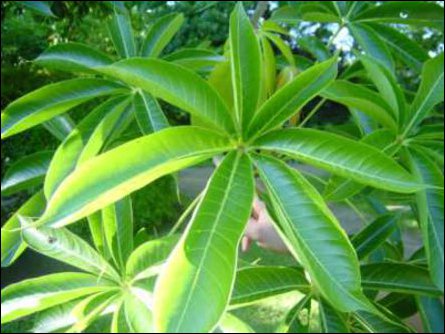
Peenaa'ri (Sterculia foetida): Foliage [Courtesy: Académie de la Réunion, Wikimedia Commons]
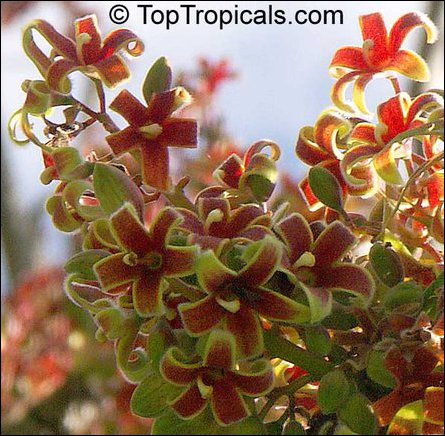
Peenaa'ri (Sterculia foetida): The blossoms of stench [Courtesy: www.toptropicals.com]
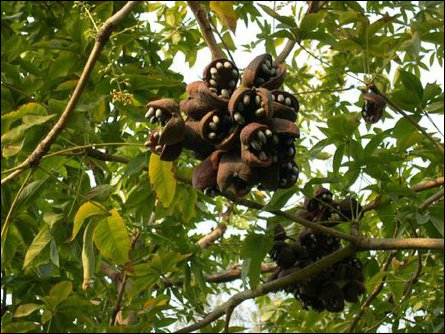
Peenaa'ri (Sterculia foetida): Fruits bursting open, exposing seeds [Courtesy: www.thaimtb.com]
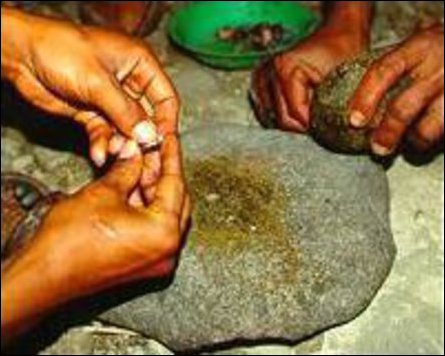
Peenaa'ri (Sterculia foetida): Traditional method of extracting oil from seeds in Eastern Indonesia [Courtesy: www.ecosea.org]
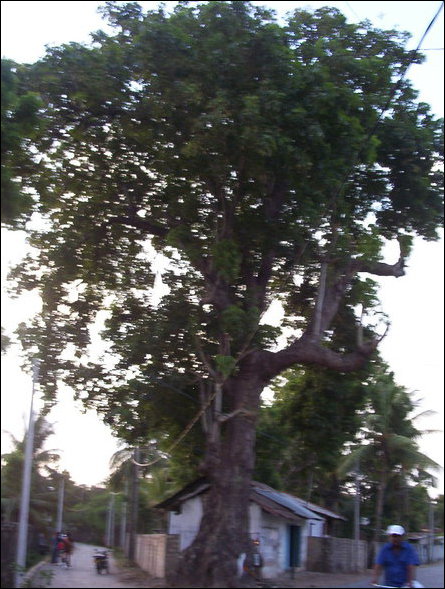
The Peenaa'ri tree that has given the name to the locality in Kokkuvil, Jaffna. [Photo: TamilNet]
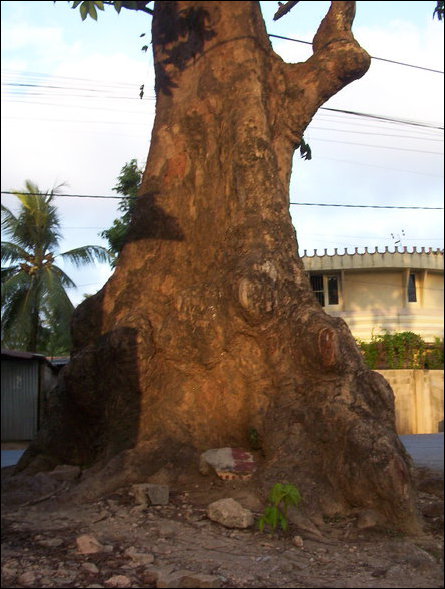
The tree is perhaps more than a hundred years old [Photo: TamilNet]
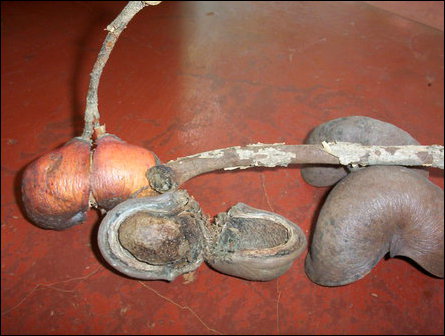
The empty shells of fruits of the tree at Kokkuvil [Photo: TamilNet]
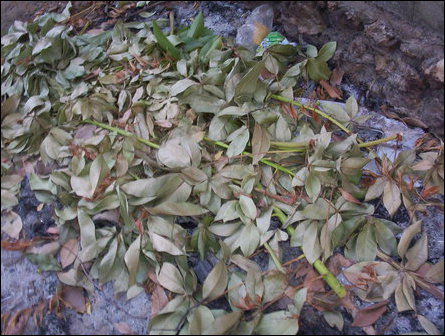
Felled twigs of the tree at Kokkuvil [Photo: TamilNet]














